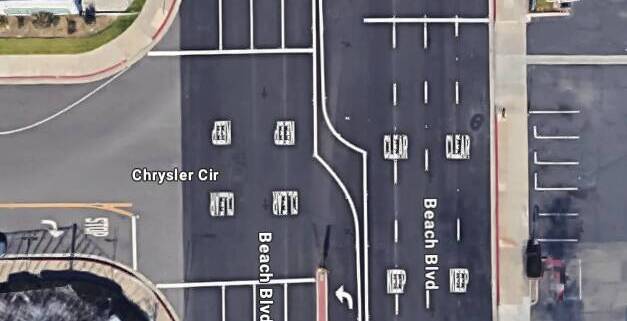New Data Sheds Light on Caltrans Projects
CalBike supported the Caltrans Data Bill, SB 695, in 2023. Starting January 1, 2026, the bill requires Caltrans to post information about projects from the prior fiscal year. But first, the new law tasked Caltrans with releasing project stats going back to 2018. CalBike has reviewed the data, which showed Caltrans was reluctant to install protected bikeways while installing more paint-only bikeways.
Caltrans built 554 new highway miles over the period covered by this data, at a time when California needs to reduce, not increase, vehicle miles traveled. At the same time, the agency built just 160 miles of bikeways, more than half of which were Class 3 lanes where bike riders share the lane with motor vehicle traffic.
While the SB 695 data doesn’t provide enough detail to fully understand Complete Streets projects on state routes, this first release of data shows that Caltrans isn’t doing enough to meet California’s goals to increase biking and walking.
Caltrans bikeways prioritized paint over protection
From the 2018/19 fiscal year through 2022/23, Caltrans added 160.37 miles of bikeways on state-controlled roads. Every Caltrans district and every California county saw some amount of Caltrans bike infrastructure, though in some cases, the amount was very small.
The total number of miles is less impressive when you break it down by class. More than half — 93 miles — was Class 3 bikeways. Class 3 bikeways are lanes with shared bicycle/car traffic, often delineated by sharrows. Caltrans also counts shoulder widening as building Class 3 bikeways; it’s hard to know how much of the 93 miles were wider shoulders on rural routes or simply regular travel lanes to be shared with bicyclists.
Another 53.2 miles were Class 2 bike lanes: lanes marked by paint. While reviewing project files for our Incomplete Streets report, we discovered that Caltrans counted the repainting of existing Class 2 bike lanes as adding Complete Streets to a project. We don’t know what percentage of the 53.2 miles were new lanes and what was simply repainting existing lanes.
Class 1 bikeways are off-road paths completely separated from vehicular traffic. Caltrans reported 11.97 miles, or a little less than 3 miles per year in the whole state of California, over the four-year period.
Caltrans built just 2.2 miles of Class 4 bikeways — separated on-street bikeways with physical protection from car traffic. That’s about half a mile per year. Many local governments in our state built more protected bikeway miles during this period.
Bikeway trends over time and space
The pandemic appears to have taken a bite out of Caltrans bike projects. It built a little more than 50 miles of bikeways in 2019 but just 4.4 miles in 2020. By 2023, that number had crept back up to 44.4 miles. The percentage of different classes of bikeway fluctuated over the covered time period, but 71% of the total bikeway miles added in 2023 were Class 3, only slightly less than in 2019.
The geographic distribution of bicycle infrastructure was also uneven. More than half of the Class 3 bikeways were added in just two counties: 37.7 miles in Kings County and 30 miles in San Bernardino County. San Diego County had 14 miles of Class 3. These three counties accounted for 81 of the 93 miles of Class 3 bikeways, likely reflecting specific projects underway during the years in question.
Caltrans added the least bike infrastructure in Merced County over this four-year period: just 0.04 miles of Class 1 path. That’s about 211 feet. The Caltrans District with the fewest miles of bikeway installed was Caltrans District 12, which covers Orange County: 1.1 miles. That included 0.1 miles of Class 1, 0.9 miles of Class 2, 0.1 miles of Class 3, and no Class 4 bikeways.
It’s not possible to draw definitive conclusions from this data, especially without knowing more about the specifics of the projects and what the bikeways actually look like. What is clear from the information we have is that Caltrans rarely built protected bikeways while installing many more miles of paint-only bikeways.
Uneven sidewalks
The data also included sidewalk construction and reconstruction. Over the four-year period of this reporting, Caltrans built 47.9 miles of new sidewalks and reconstructed another 28.9. The pandemic didn’t seem to have as big an effect on sidewalk construction; it went up in 2020 and has bounced up and down in the years since.
There was sidewalk work in every district, with some notable highs and lows. District 12, once again, built the fewest sidewalks, with 0.1 miles of new sidewalks and 1.5 miles reconstructed. Amador County had the fewest sidewalk improvements, just 0.03 miles of new sidewalk. Santa Clara and Solano Counties had no new sidewalks and less than a mile of reconstructed sidewalks.
At the other end of the scale, Los Angeles County got 17.68 miles of new sidewalks and 5.73 miles reconstructed. LA alone accounted for almost a third of the sidewalk construction on state-controlled routes.
Again, it’s hard to draw too many conclusions without reviewing the original project documents, which are not available online. And the report doesn’t quantify other pedestrian elements that may be vital during road repair projects, such as new crosswalks or protected intersections.
Highways keep on truckin’
Caltrans built 554 miles of new highways during this four-year window, a time when major climate disasters were accumulating across California. It’s past time to stop building new highways and spend our transportation resources on other travel modes.
While some of the new miles were ramps and interchanges, almost 40% — 214 miles — were general purpose lanes that will add more vehicle miles traveled, more pollution, and more climate stress.
Almost a quarter of all the new highway building was done in LA County, though the majority of that road building was High Occupancy Vehicles (HOV) and toll lanes rather than general purpose lanes. San Bernardino County built the most new general purpose roadway: 62 miles.
More data = good
There are additional tables with information about buildings moved and planned and pending projects. You can find it all at https://dot.ca.gov/programs/asset-management/select-state-highway-system-project-outcomes.
As we get more data from Caltrans, more trends and avenues for improvement will become apparent. The SB 695 reports should, over time, become a helpful resource to track Caltrans’ progress toward focusing on projects that serve all road users.





